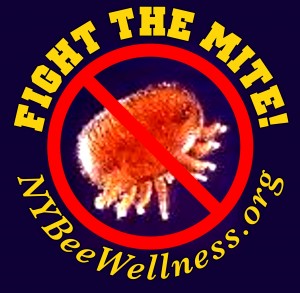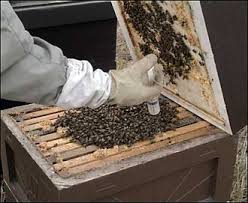DWV
Newsletter Winter 2022 NY Bee Wellness
Late Fall 2019 NY Bee Wellness Newsletter
Swarm, Varroa Count, & Virus mapping
Use of Oxalic Acid on Honey Bees
Use of Oxalic Acid on Honey Bees
- Can be used as a dribble/trickle, vapor, or spray.
- Most effective on broodless colonies
- Can be used on newly hived bees (package or swarms) within 9 days of hiving.
- Once diluted in solution, oxalic will degrade quickly. Can be refrigerated few a few days only.
- Use protective gear.
- Cannot be used when honey supers are on hive.
Randy Oliver’s page: http://scientificbeekeeping.com/oxalic-acid-questions-answers-and-more-questions-part-1-of-2-parts/
Protocol from the Canada OBA Tech Transfer Program: oxalic-acid-protocol OBA TTP
Detailed instructions: Oxalic- approved label with detailed instructions
Use only in late fall or early spring when little
or no capped brood is present. Oxalic Acid Dihydrate
might damage bee brood. Oxalic Acid
Dihydrate will not control Varroa mites in
capped brood.
Do not use when honey supers are in place
to prevent contamination of marketable
honey.
Apply only when monitoring indicates
treatment is required. Consult state
guidelines and local extension experts for
monitoring protocols and thresholds for
treatment.
December, a broodless period in the hive, is the best time for treating for mites with an oxalic dribble.
* Short videos on oxalic dribble technique:
1) https://www.youtube.com/watch?v=7tpYTqqDaHI
2a) Close-up version, https://vimeo.com/84454537
Resources:
Oxalic acid A prospective tool for reducing Varroa; M. Ellis, University of Nebraska; 2009
Randy Oliver’s Power Point on Oxalic usage: http://scientificbeekeeping.com/oxalic-acid-powerpoint-presentation/
Oxalic and Hopguard II update
March 19, 2015-
The EPA issued an approval (section 3) for Oxalic Acid Dihydrate 97% to be used as a miticide on March 10.
Hopefully the availability of labeled Oxalic Acid and the NYS DEC approval should take place in a few weeks.
In New York, the Department of Environmental Conservation (DEC), must approve the label. Letters of support/need should be communicated to:
NYS DEC Bureau of Pest Management, Pesticide Registration Section, 625 Broadway, Albany, NY 12233-7254 ATTN: Jeanine Broughel For email comments: ppr@dec.ny.gov
Please check back for additional info and fact sheets.
The label lists:
Directions for Use- application direction (solution or “dribble” method; Vaporizer method; Spraying Package Bees),
Resistance Management
Storage and Disposal
Precautionary Statements- Hazards to Humans and Domestic Animals; Warnings; First Aid
Registration Number
Links: NOTE- for general information,some content needs updating
http://scientificbeekeeping.com/oxalic-acid-questions-answers-and-more-questions-part-1-of-2-parts/
———————————————
HOPGUARD II
An improved delivery system: strips contain 4.0 grams of the potassium salt of hop beta acids per strip The original HopGuard contained 1.92 grams of the potassium salt of hop beta acids per strip.
The Hop Guard II Section 18 Emergency Exemption recertification should be under review by the EPA.Paperwork to the DEC was submitted on February 26th for them to formally request the recertification from the EPA.Anticipate communication from the DEC on the EPA’s decision in the next couple of weeks.


